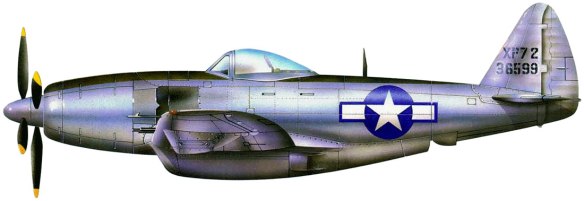XP-72 Serial: 36599 (43-6599) The second prototype equipped with Pratt & Whitney R-4360 engine with contra-rotating propellers. Basically a P-47 airframe wrapped around a massive radial engine, the XP-72 was designed as a fast and fast-climbing interceptor to match German flying bombs. Its unofficial top speed of nearly 500mph made it probably the fastest piston-engined aircraft ever.
The Republic XP-72 was based upon the P-47 airframe and was designed by Alexander Kartveli’s fighter team as a ‘Super Thunderbolt around the 3,000-hp (2237.1-kW) Pratt & Whitney R-4360-13 Wasp Major radial engine. The powerplant was, simply, the most powerful piston engine to reach production in any country during World War II. Intended primarily to be faster than the Thunderbolt, the XP-72 was viewed in part as a remedy for the Third Reich’s high-speed V-1 buzz bomb. The USAAF planned to use the fighter to intercept buzz bombs, taking advantage of its ability to reach 20,000 ft (6096 m) in just under five minutes. An armament of six 0.5-in 112.7-mm) guns would have been carried.
The first of two examples (43- 6598) flew a t Farmingdale on 2 February 1944 using a large four-bladed propeller. The name of the pilot is not recorded, but C. Hart Miller was active in Republic flight test at the time. The second XP-72 (43-6599) flew in July 1944 with the intended Aeroproducts six-bladed contra-rotating propeller. The second aircraft, however, was lost on an early flight. With priority shifted to long-range escort fighters, this promising interceptor was not needed. The other XP-72 airframe is thought to have been scrapped at Wright Field around VJ-Day.
Specifications (XP-72)
General characteristics
Crew: One
Length: 36 ft 7 in (11.15 m)
Wingspan: 40 ft 11 in (12.47 m)
Height: 16 ft (4.88 m)
Wing area: 300 ft² (27.9 m²)
Empty weight: 11,476 lb (5,216 kg)
Loaded weight: 14,433 lb (6,560 kg)
Max. takeoff weight: 17,490 lb (7,950 kg)
Powerplant: 1 × Pratt & Whitney R-4360-13 radial engine, 3,500 hp (dash 13 engine) (2,574 kW)
Performance
Maximum speed: 490 mph (789 km/h)[1][N 1]/ 387mph (623 km/h at sea level)
Range: 1,200 miles (1,932 km)
Service ceiling: 42,000 ft (12,805 m)
Rate of climb: 5,280 ft/min (26.8 m/s)
Wing loading: 48.1 lb/ft² (235 kg/m²)
Power/mass: 0.24 hp/lb (0.39 kW/kg)
Armament
6× 0.50 in Browning machine guns
or
2x 37mm M4 cannons and 4x 0.50 in Browning machine guns
or
4x 37mm M4 cannons
2× 1,000 lb (476 kg) bombs
